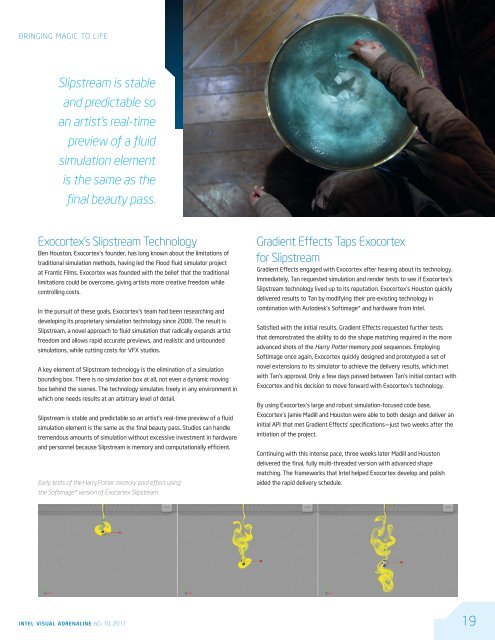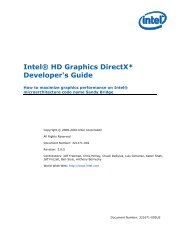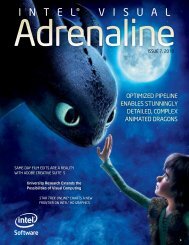Intel ® Visual
Intel ® Visual
Intel ® Visual
Create successful ePaper yourself
Turn your PDF publications into a flip-book with our unique Google optimized e-Paper software.
inging magic to life<br />
Slipstream is stable<br />
and predictable so<br />
an artist’s real-time<br />
preview of a fluid<br />
simulation element<br />
is the same as the<br />
final beauty pass.<br />
Exocortex’s Slipstream Technology<br />
Ben Houston, Exocortex’s founder, has long known about the limitations of<br />
traditional simulation methods, having led the Flood fluid simulator project<br />
at Frantic Films. Exocortex was founded with the belief that the traditional<br />
limitations could be overcome, giving artists more creative freedom while<br />
controlling costs.<br />
In the pursuit of these goals, Exocortex’s team had been researching and<br />
developing its proprietary simulation technology since 2008. The result is<br />
Slipstream, a novel approach to fluid simulation that radically expands artist<br />
freedom and allows rapid accurate previews, and realistic and unbounded<br />
simulations, while cutting costs for VFX studios.<br />
A key element of Slipstream technology is the elimination of a simulation<br />
bounding box. There is no simulation box at all, not even a dynamic moving<br />
box behind the scenes. The technology simulates freely in any environment in<br />
which one needs results at an arbitrary level of detail.<br />
Slipstream is stable and predictable so an artist’s real-time preview of a fluid<br />
simulation element is the same as the final beauty pass. Studios can handle<br />
tremendous amounts of simulation without excessive investment in hardware<br />
and personnel because Slipstream is memory and computationally efficient.<br />
Early tests of the Harry Potter memory pool effect using<br />
the Softimage* version of Exocortex Slipstream.<br />
Gradient Effects Taps Exocortex<br />
for Slipstream<br />
Gradient Effects engaged with Exocortex after hearing about its technology.<br />
Immediately, Tan requested simulation and render tests to see if Exocortex’s<br />
Slipstream technology lived up to its reputation. Exocortex’s Houston quickly<br />
delivered results to Tan by modifying their pre-existing technology in<br />
combination with Autodesk’s Softimage* and hardware from <strong>Intel</strong>.<br />
Satisfied with the initial results, Gradient Effects requested further tests<br />
that demonstrated the ability to do the shape matching required in the more<br />
advanced shots of the Harry Potter memory pool sequences. Employing<br />
Softimage once again, Exocortex quickly designed and prototyped a set of<br />
novel extensions to its simulator to achieve the delivery results, which met<br />
with Tan’s approval. Only a few days passed between Tan’s initial contact with<br />
Exocortex and his decision to move forward with Exocortex’s technology.<br />
By using Exocortex’s large and robust simulation-focused code base,<br />
Exocortex’s Jamie Madill and Houston were able to both design and deliver an<br />
initial API that met Gradient Effects’ specifications—just two weeks after the<br />
initiation of the project.<br />
Continuing with this intense pace, three weeks later Madill and Houston<br />
delivered the final, fully multi-threaded version with advanced shape<br />
matching. The frameworks that <strong>Intel</strong> helped Exocortex develop and polish<br />
aided the rapid delivery schedule.<br />
intel visual adrenaline no. 10, 2011 19













